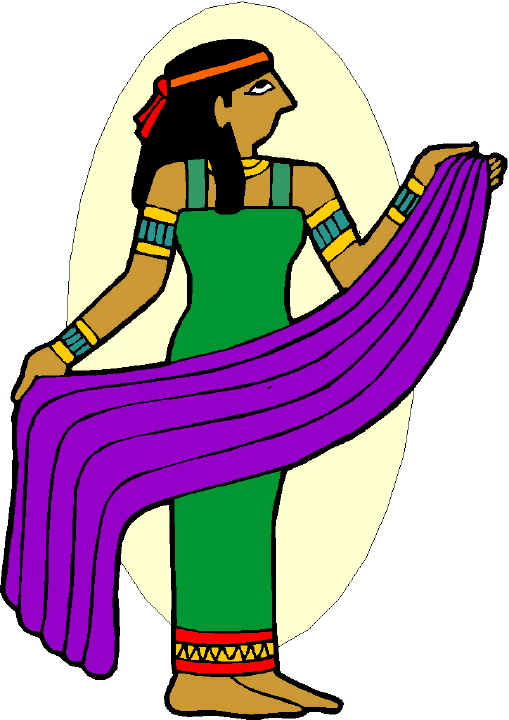

Fashion in the Ancient Land of the Nile
A little girl sat quietly, admiring her graceful mother as she dressed for a banquet. Precious stones, set in gold, gleamed against the woman’s dark hair. Heavy golden necklaces lay richly over the fine linen of her dress. She called her daughter to her side and, selecting an amulet from amongst her finery, fastened it in the child’s hair. It would serve to protect the girl in her absence.
Linen
Clothing
Baubles and Ba
How Do We Know That?
The ancient Egyptians appreciated beauty. They created ornate buildings and magnificent statues. The Egyptians themselves were often decorated too. Elaborate, symbolic jewelry and fine clothing were a part of life for all.
Linen
Clothing
Ancient Egyptian clothing was made mainly from
linen. This lightweight fabric  is
made from the fibers of flax plants. Egyptian
weavers produced such high quality linen that it became a major trade export.
is
made from the fibers of flax plants. Egyptian
weavers produced such high quality linen that it became a major trade export.
Egyptian men wore pleated kilts and, when it was cool, simple tunics. Women wore long, straight dresses with shoulder straps. Cooler weather called for shawls or long cloaks. Women of the highest classes sometimes wore beaded dresses. Ancient Egyptian children did not usually wear clothes until they were teenagers.
In ancient Egypt, people did not normally wear shoes;
they went barefoot. Sometimes, though, they did wear sandals made from reeds or
braided papyrus.
Top of Page
Baubles and Bangles
Mines between the Nile River and the Red Sea yielded
large amounts of metals such as gold and copper.
Using these metals, Egyptian craftsmen fashioned elaborat e headbands,
earrings, necklaces, bracelets, rings and anklets. They also made fancy collars called weesekhs.
Jewelry was often set with precious stones such as onyx, turquoise and
garnet. These ornate jeweled pieces
were usually worn by royalty. Everyone
in ancient Egypt wore jewelry, though lower class people had plain copper
bracelets and necklaces of glass or glazed, glass-like beads.
e headbands,
earrings, necklaces, bracelets, rings and anklets. They also made fancy collars called weesekhs.
Jewelry was often set with precious stones such as onyx, turquoise and
garnet. These ornate jeweled pieces
were usually worn by royalty. Everyone
in ancient Egypt wore jewelry, though lower class people had plain copper
bracelets and necklaces of glass or glazed, glass-like beads.
Not all ancient Egyptian jewelry was for decoration.
Little charms, called amulets, were worn because the Egyptians believed
they had magical powers. There were many different amulets and each type was
thought to have its own special protective power. Children and adults wore
amulets on necklaces and bracelets, or in their hair. When people died, amulets
were buried with them.
Top of Page
How Do We Know That?
Early
in the Year 2000, a man named David Pinault was doing research at the
Rosicrucian Egyptian Museum when he made an important discovery.
He found an artifact card and several letters referring to an ancient
bronze ring stowed away somewhere in the museum.
After much searching, the ring, which had once belonged to the Egyptian
Pharaoh Akhenateh (Amenhotep IV), was finally found.
The ring is over 3,000 years old.
Top of Page
Some images on this page are © 2000-2001 www.arttoday.com.